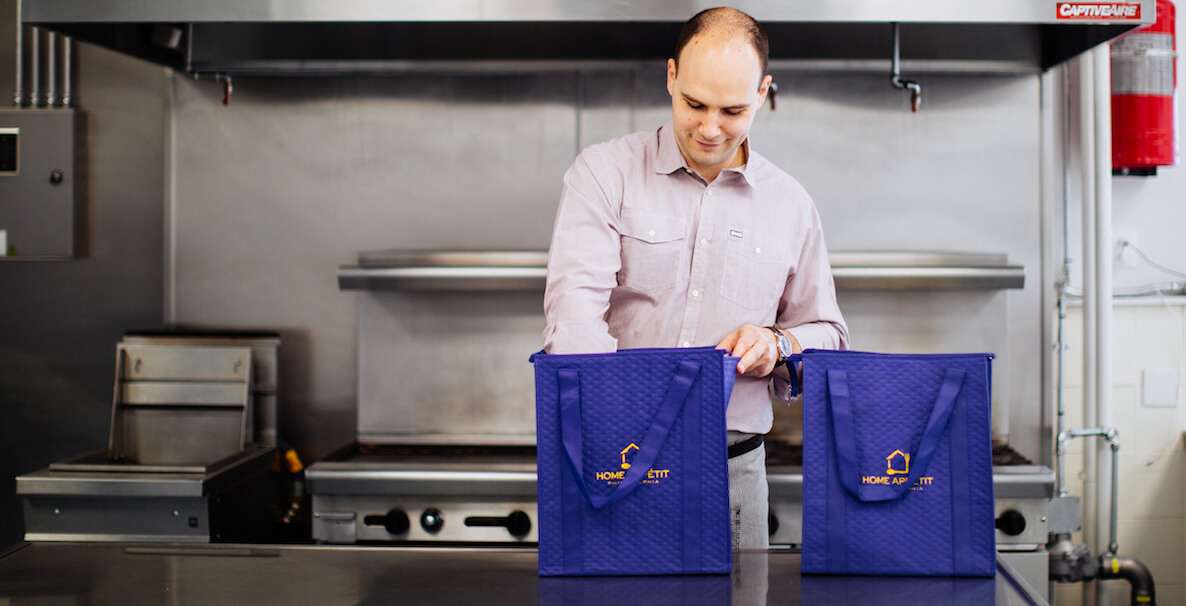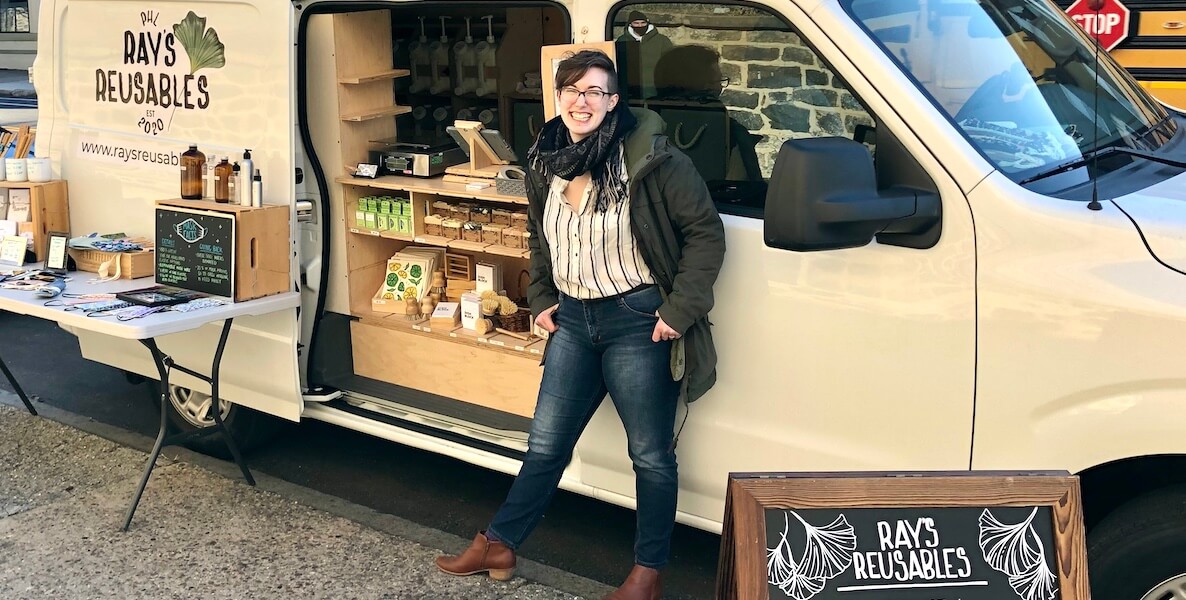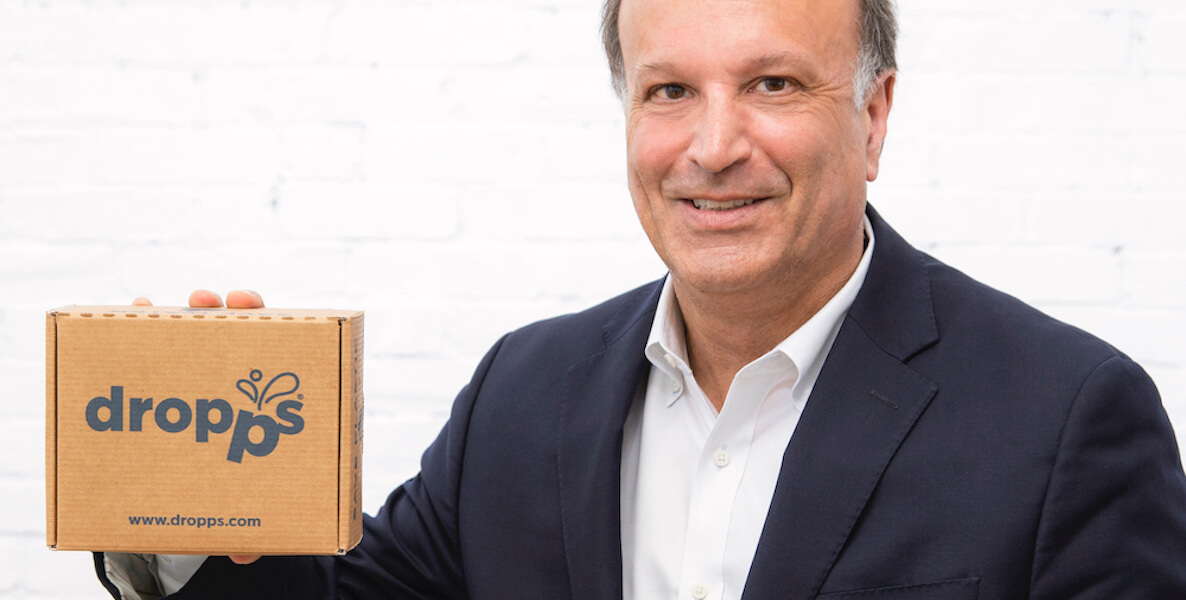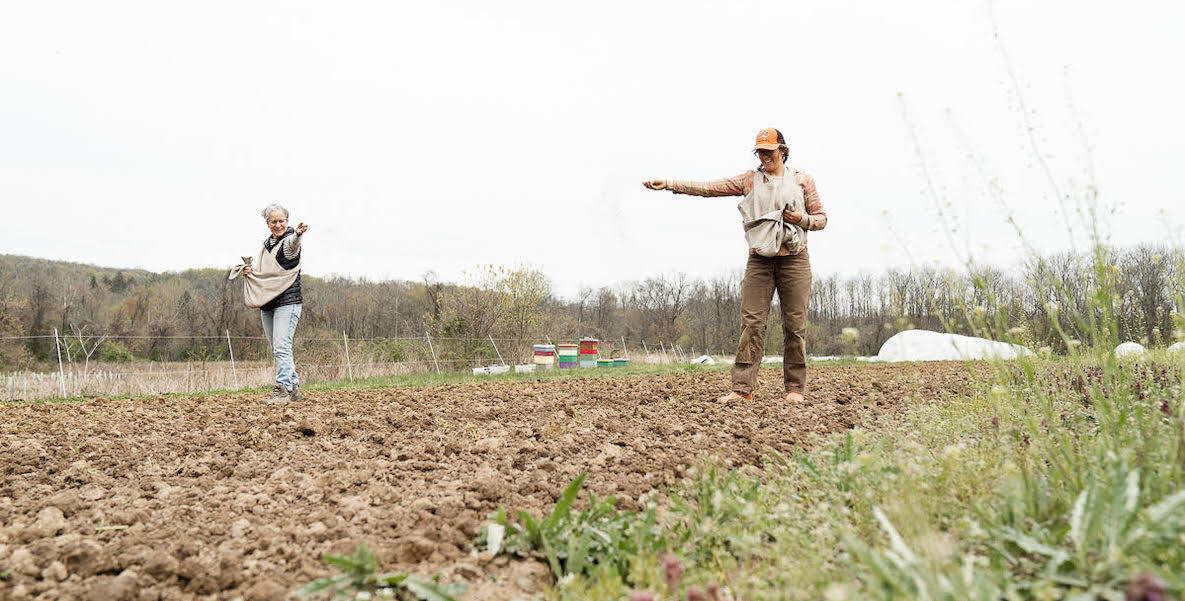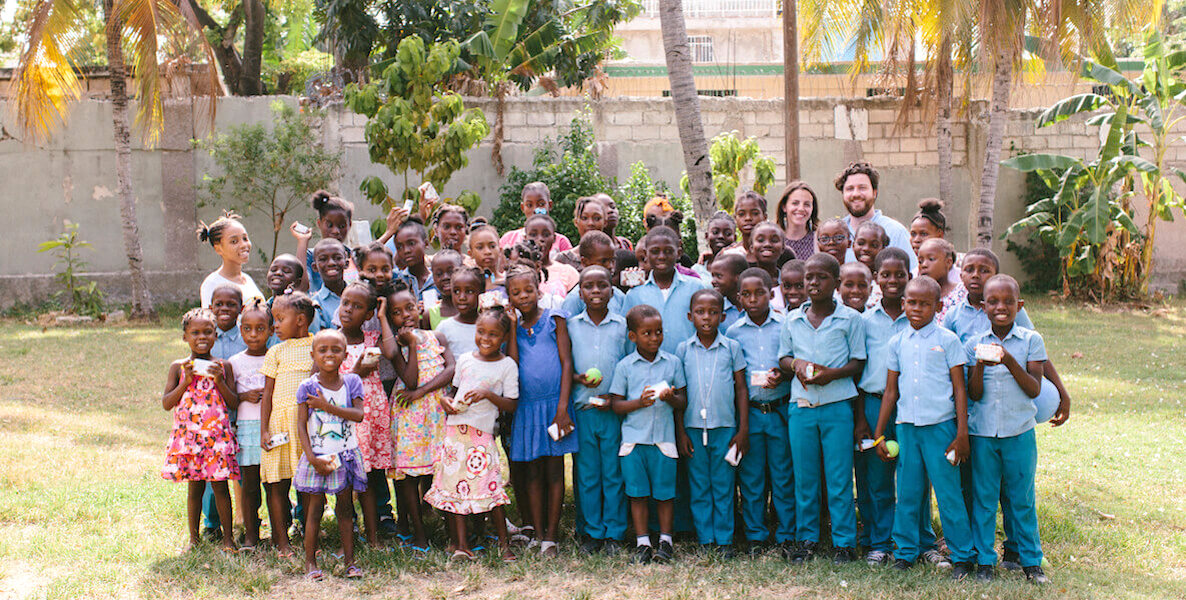For Bill Glaab and Courtney Apple, the inspiration that would give rise to their business, Philly-based Hand In Hand, looked less like a lightbulb moment, and more like a slow burn. The seeds for their eco-friendly, socially-minded soap biz were first planted way back in 2008, when the college sweethearts were still very young: Apple, an Ardmore native, had just graduated from Hobart and William Smith Colleges; Glaab was two years out, working in financial sales. They were on a trip to celebrate Apple’s graduation when they read a story in an in-flight magazine that sparked something in them.
The piece was about Tom’s, the then-burgeoning shoe company that’s now a B Corps famous for its one-to-one model of donating a pair of shoes for every pair bought. “We spent the better part of the flight talking about how cool it would be to start a business”—a for-profit model as a means to a meaningful end—“that could give back like that one day,” Glaab says. “And then we spent the next three years talking about what might work.” Since then, of course, a focus on mission has become a central tenet of modern business—as well as a selling point to would-be employees and customers, alike. Look no further than the burgeoning B Corp realm for proof.
MORE ON LOCAL BUSINESSES DOING GOOD
The “what might work” part of the idea came around in 2011, at the one-year mark of the earthquake that had devastated Haiti the previous January. There was a lot of news coverage of the anniversary at the time, Glaab recalls, and a couple of themes had emerged in the stories.
Firstly, it struck the pair how much of the money donated toward the recovery had been mismanaged, obliterating the positive impact it might have had. The second aspect that made an impression was the lingering need not just for clean water—a topic that had attracted a lot of attention and some amount of aid—but also, apparently, for soap to use with that water. One story focused on a group that was taking soap down to Haiti, Glaab says, and the piece cited a statistic that some five million children under the age of five died every year from water-related illnesses. And, the story noted, nearly half of those deaths—half!—could be prevented with hand-washing.
In 2012, they took their first soap donation trip to Haiti, where they saw firsthand—and felt, quite deeply—the effect their giveback model could have on people’s lives. If they needed any validation at all for the mission driving their work, this was it.
So there you have it. Glaab and Apple—by this time, married—founded Hand in Hand, which creates vegan, cruelty-free, eco-friendly and sustainable soaps (plus lotions, hand sanitizers and body scrubs), and follows the Tom’s model: For every product bought, a bar of soap and a month’s worth of clean water goes toward kids in need in Haiti.
The duo self-funded and started small, with headquarters inside their cozy Washington Square West house. Apple worked part-time, keeping her other job as a photographer. They partnered with My Neighbor’s Children, a nonprofit that focuses on child advocacy, and, in 2012, got to take their first soap donation trip to the country, where they saw firsthand—and felt, quite deeply—the effect their giveback model could have on people’s lives. If they needed any validation at all for the mission driving their work, this was it.
Meantime, 2012 marked another validating first back at home: Hand in Hand landed in Anthropologie, a massive boost for the new business. From there, the brand would take off on a circuitous road filled with the sort of forks so many entrepreneurs face (more on that in a minute), as well as a number of impressive milestones: National press! Placement in Target! Seven new wells dug in Haiti! And then, this past March, not long after they’d donated their 13 millionth bar of soap, came another big breakthrough: Hand in Hand sold a majority stake in the business to Bain Capital Double Impact, essentially the gold-standard investor when it comes to mission-driven companies.
It’s the type of business- and life-changing move that finds its way into newspaper headlines. But like everything else they’ve done, the couple will tell you that the Bain deal comes back to the original mission they’ve had from the start, the raison d’etre they dreamed up in 2008, before the soap even came onto the scene. And that, Glaab says, is really about “harnessing the power of business as a collective force to do good in the world.”
Standing above the competition
As far as the soap goes, though, there are a handful of things that set the brand apart beyond its buy-one-give-one mission. Sustainability, for one, was baked in from the beginning as part of the brand vision. Hand in Hand eschews palm oil, a major ingredient in the vast majority of soaps that’s also linked to the decimation of the rainforests, wildlife devastation, and human rights’ abuses.
That mix—clean ingredients inside pretty packaging that didn’t look “crunchy” (Glaab’s word)—was a rarity at the time. It helped: Anthro doesn’t really go for plain-Jane.
This was not a simple or inexpensive decision to make when it comes to manufacturing. In fact, Glaab adds, “we were very naive saying at the start, Oh, we’re just not going to use palm oil,” but so be it: It was something they believed in, and also something that helped them stand out in the sea of other suds. They stuck to it, and found a manufacturer in Vermont who helped them craft their formula, which today comes in a handful of mild scents with names like “cactus blossom”, “sea salt” and “citrus grove.”
They also had Apple, a professional photographer with an artist’s eye. “I think it would have been a horrible looking brand without her,” Glaab says. The design has gone through a rebrand since its early days, but from the start, the brand aesthetics have been colorful, upscale, beautiful. That mix—clean ingredients inside pretty packaging that didn’t look “crunchy” (Glaab’s word)—was a rarity at the time. It helped: Anthro doesn’t really go for plain-Jane.
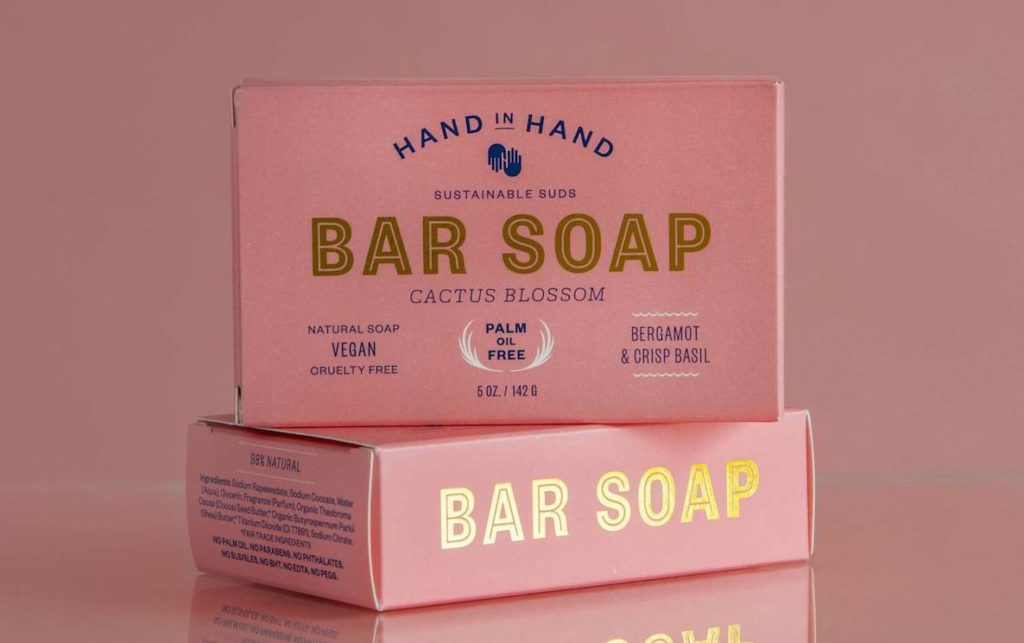
Not long after the Anthropologie placement, Hand in Hand started popping up in boutiques around the country. Their business grew; they moved into a 1,500-square-foot garage, and started making candles and bath salts, then moved again into Global Dye Works in Kensington, and started making “everything under the sun you could make with oils and butters,” Glaab says.
Things were rolling. They got a $300,000 loan from PIDC. They had nearly 100 products, a few employees, a Philly location for making them … and also, financials that weren’t working out. The cost of manufacturing was outstripping their profits.
So they pivoted. Glaab cold-called Target—this was late 2016—and Target bit. They were in stores by the holidays, and from that point on, Hand in Hand was on a new path. They pared their offerings way down, left Kensington, got a small place in South Philly, and outsourced all manufacturing to factories in Vermont, New Jersey and Pennsylvania in order to make enough for what had become their lone customer, Target.
2017 was a big year, and the beginning of serious momentum. The duo rebranded for a cleaner, more modern look, took on a single angel investor (for debt, not equity; they paid off the loan last year), and passed the million-bar mark for donations. In 2018, they partnered with a second nonprofit called Eco-Soap Bank, which employs disadvantaged women around the world to recycle soap that gets to communities in need, and brought Hand in Hand into Cambodia.
Over the next couple of years, Hand in Hand basically exploded. Or haven’t you seen them in CVS? Kroger? Whole Foods? (Whole Foods was a biggie: Glaab says that in 2019, the year Whole Foods started stocking their products, they tripled business.)
As fate—luck? karma?—would have it, the pair decided to make liquid hand soap in 2019, not terribly long before Covid hit. (They hadn’t sold liquid soap in some years; it was hard to do at scale.) They’d also found a partner to package it in infinitely recyclable aluminum rather than plastic—something even the soap giants weren’t doing because of scale issues, and something that would further set them apart and serve their mission. They pitched a 2020 release for Whole Foods, and 2021 release for Target. And then the world shifted under all of our feet.
A different kind of pivot
It goes without saying that running any business during Covid was, at the very least, a challenge. But when your business is soap? A different type of challenge entirely: The giant big-name manufacturers couldn’t keep up with the sudden demand. And there was Glaab, shooting a note to Target, reminding them that, hey, Hand in Hand made some soap. Sixty days later, they had their liquid hand soap and sanitizer shipped out to Target … and then Wegman’s and Fresh Thyme and CVS and Walmart, and so on. Their revenue grew by 13 times in 2020, and they sold more than 10 million units.
“Admittedly,” Glaab says, “a lot of small brands did this on some level, and filled in for the big guys.” But those brands didn’t have the decade of resonant brand-building on that sustainable, do-good ethos like Hand in Hand did; they didn’t have the established platform in top-tier retailers. “After the Covid search died down, people kept buying us,” he says. Today, they’re in 15,000 stores, selling at a price point ($5 for 10 ounces) that’s noticeably more than big-name basics, say, Dial or Softsoap, but just a smidge higher than brands like Mrs. Meyers or J.R. Watkins.
“It really did take us 10 years to get to this point, and we still have a long road to go,” Glaab says.
Meantime, the success in sales has meant more donations—they’re at almost 14 million bars of soap donated now—and also a wider distribution, mostly because their nonprofit partners expanded to fill needs more globally. Until Covid, Hand in Hand had been in a small number of countries, Glaab explains, because that’s where their nonprofit partners were, and they wanted to “go deep” and donate soap sustainably, to “help kids through adulthood, not one bar of soap, and we never see them again.” As the nonprofits expanded to help more people, so, too, did Hand in Hand.
Another development of note is the 80 new fresh-water wells that they’re working to dig and repair with their nonprofits in Haiti now—“a direct impact from product sales during Covid,” Glaab says. (“We purchased sophisticated well-digging equipment and donated to our nonprofit partner in Haiti, who hires locally for labor,” Glaab says.)
Given all this, it’s not shocking that Hand in Hand caught the highly selective eye (and wallet) of BCDI, though it’s worth noting that they’re the first consumer product of its type in the portfolio. The Hand in Hand deal is currently displayed front and center on the equity firm’s site, which fairly raves over the business:
In a sea of beauty and personal care brands that seek to be sustainable and socially conscious, Hand in Hand Soap stood out to us because of its commitment to environmental and social stewardship from production through consumption.
Is this the sort of success they’d imagined and been working toward? Glaab doesn’t take a beat before he says, “Well, ‘successful’ was always on the checklist for the brand.” (By the way: Neither one of the entrepreneurial pair had ever formally studied business before launching the brand. Glaab, a political science major, does say that the Goldman Sachs 10,000 Small Businesses Program he took through Philadelphia Community College was a helpful crash-course as they grew Hand in Hand.)
All that said, of course they didn’t predict all the turns that would lead them here, nor did they necessarily absorb at the outset the old adage that overnight success in business takes a decade, Glaab will tell you: “It really did take us 10 years to get to this point, and we still have a long road to go.” What Bain means to them now is “financial and thought partners who are aligned with us, and actually care about impact.”
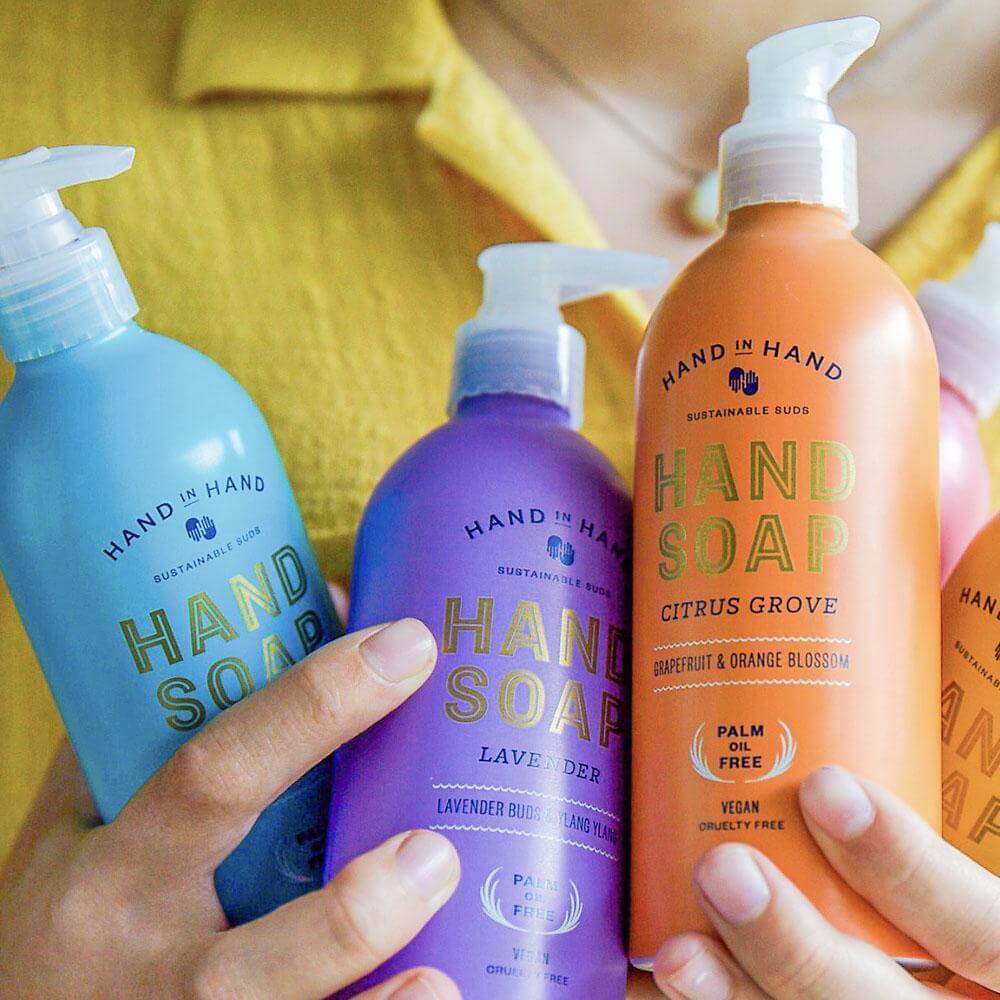
And that means growth. They’d already been growing the team—for years, they had been operating with three independent employees, plus Glaab and a part-time Apple; in 2020, they bumped up to 8 people; and now, in 2021, they’re at 15, with plans to get to 20. They also just launched at another mega-retailer, Sprouts, and they’re currently in the process of looking for a CEO who can guide the company from the start-up stage into and through the growth stage. As the executive chairman, Glaab will focus on strategy rather than day-to-day operations; Apple will still helm the aesthetic aspect, keeping it all cohesive as it evolves.
They’re also currently throwing energy into getting certified as a B Corp—something they haven’t had the chance to really tackle before, but are prioritizing for 2021—and pushing forward on the sustainability story, moving all products into aluminum and working on a bottle pump that’s recyclable. The industry hasn’t quite gotten there yet, Glaab says, but Hand in Hand is determined to find a way to do even this better … which tracks with the brand, and the ethos of the founders who continue to nurture it.
Header photo courtesy Hand in Hand


